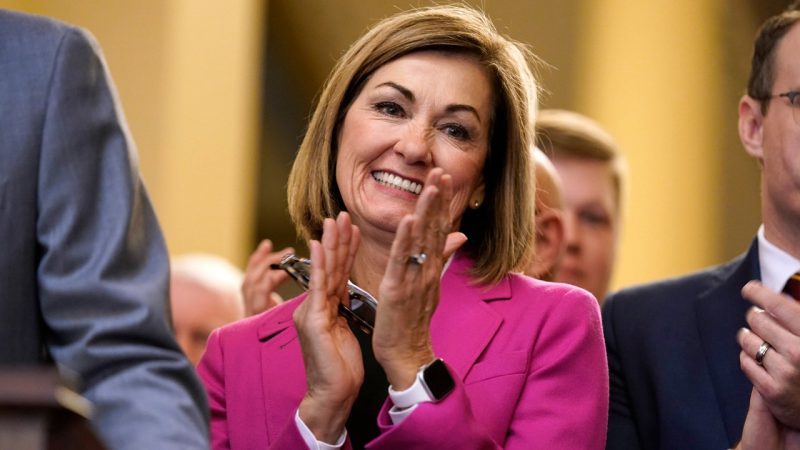
Iowa Gov. Reynolds claims state government overhaul already showing results
An extensive reorganization of Iowa’s state government to streamline services is complete and already translating into improvements after just three months, Gov. Kim Reynolds said, even as some continue to worry that the massive transition consolidates the governor’s power and diminishes accountability.
Reynolds proposed the alignment as one of her top priorities at the beginning of the year, envisioning the shrinking of departments from 37 to 16 and the elimination of more than 500 positions. She signed the bill into law on April 4 after it passed in the Legislature without any substantive changes.
The 16 beefed-up agencies are now fully operational, Reynolds said, and already seeing ‘measurable outcomes.’
‘I think it’s sometimes difficult to grasp the size and scope of this undertaking, especially with such an aggressive timeline,’ Reynolds said Tuesday. ‘The most compelling reasons why alignment is the right thing to do for Iowans are the early success stories that we’re hearing across state government.’
Reynolds also unveiled a new state logo with the tagline ‘Freedom to Flourish,’ which she said will bring all of the departments together under one unified brand and communicate ‘a motivating message that in Iowa, you can reach your potential.’
What are the Core Departments?
The administration touts the reorganization as an effort to eliminate redundancies across the agencies by allowing areas with commonalities to be housed under the same roof and be subject to consistent oversight, technologies and procedures.
In particular, the Department of Inspections, Appeals and Licensing has absorbed many of the licensing services that had been in other departments. The director, Larry Johnson, said Tuesday that they have already seen dramatic cuts in case backlogs and in the average response time to requests.
Johnson said they have a ‘leaner and more efficient’ process after they took ‘talented, passionate, hardworking public servants who were doing similarly situated work as their counterparts in other departments, put them together, questioned the process with the goal of improving our services.’
The Division of Labor, Division of Workers’ Compensation, and Civil Rights Commission have also been folded into Johnson’s department.
The Department of Education and the Department of Health and Human Services both ballooned in size and scope as well.
Each department has their own director to oversee all operations within the new agency’s scope. That director is appointed by the governor and serves at her pleasure, the new law specifies.
What are the Benefits?
The state said the reorganization is projected to save more than $200 million over the next four years, largely by eliminating the roughly 500 positions that had been unfilled.
Kelly Garcia, the director of health and human services, said divisions were doing overlapping work for years before the consolidation.
They ‘were duplicative or disparate, they were disjointed,’ Garcia said. ‘I saw Iowans getting stuck in our system, getting shuffled around and sometimes really poor outcomes.’
Reynolds and her department heads also pointed agencies as a ‘one-stop shop’ for services, where before Iowans might have had to visit multiple agencies for one issue.
What are the Concerns?
Democratic lawmakers expressed concern that a smaller number of political appointees now have greater power, with more breadth and depth to their agencies.
‘There isn’t a person in this room who doesn’t want a responsive, streamlined government,’ said state Sen. Pam Jochum, who is now the leader of the Democratic caucus, during debate. ‘In my humble opinion, what we are putting at risk is oversight and accountability. What I believe is happening is a government that will be less responsive to everyday Iowans.’
Some pointed out that critical human rights functions, like the civil rights commission and the departments devoted to resources for blind and deaf Iowans, are now buried in other agencies, which could give their directors less authority to advocate for Iowans who need those services.
The director of the Department of Corrections, as compared with members of a localized board, now has authority over the operations that serve more than 30,000 individuals. Across the state, community and county leaders had questioned how effective the program will be when they lack control over their own services.
The law also gives the state’s attorney general more authority, specifying that departments cannot seek outside legal counsel and that the attorney general can prosecute any case on behalf of the state, even if a county attorney doesn’t request such an intervention. In particular, the law asserts that the attorney general alone should investigate allegations of election misconduct.
Who is Affected?
All Iowans are likely affected in some way by the state government reorganization, shifting where they go or who they contact for the services they need.
More than 2,600 state employees transitioned to a new department as part of the reorganization, Reynolds said Tuesday. She reported that the department heads have regularly communicated with employees to ensure a smooth transition, and many have had or will have the opportunity to advance and take on new responsibilities.
<!–>
–>
